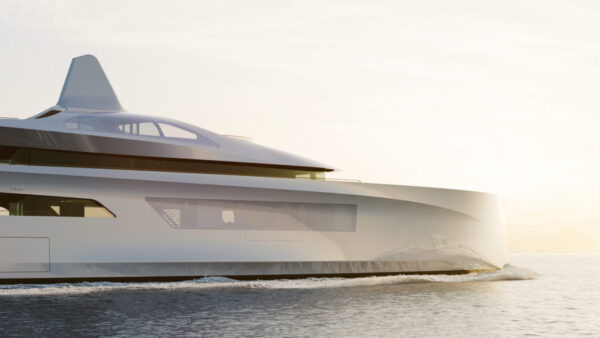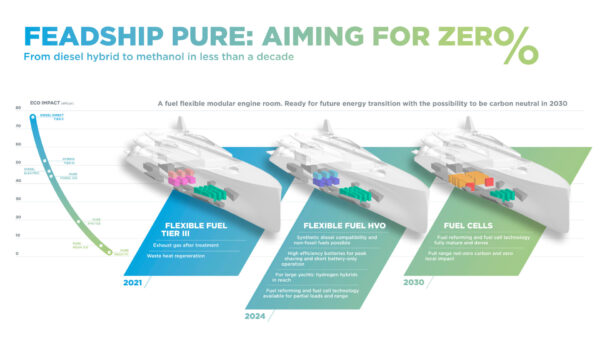From hybrids to zero emissions in less than 10 years: the 2030 roadmap for Feadship yachts
Feadship is preparing for a sustainable future with an evolutionary research process aimed at creating “agnostic” propulsion systems

Feadship is preparing for a sustainable future with an evolutionary research process aimed at creating “agnostic” propulsion systems
For Feadship, sustainability is an important term, applied to research and the construction of every new project for some time already. It is the keystone of the entire evolutionary process for the Dutch shipyard, part of a roadmap which has as its final objective in 2030, to reach zero emissions in the environment for each of its yachts.
PURE: 81.75 METRES OF SUSTAINABILITY
Pure, presented by Feadship in 2021 and already approved in principle by Lloyds Registry for its “agnostic” fuel system, is a concept that , summing up the best in aesthetic and functional space innovation for a superyacht for an owner and guests, represents a fundamental step in the research for sustainable methods of propulsion.
Already considered to be the “second phase” of the road map to the creation of zero emission yachts by 2030, it uses ascertained and now widespread technology included in the IMO NOx Tier III provision on the reduction of emissions, like post-treatment of waste gas, generation of residual heat and the use of direct current (DC) electrical systems for propulsion and energy used for on board services. But above all it is ready for the future, thanks to its compatibility with the fuels of tomorrow: Pure is an “energy hybrid” yacht, using diesel-electric propulsion supplied by batteries and liquid fuel.

FEADSHIP’S ROADMAP
“The next crucial step – explains Giedo Loeff, R&D manager for Feadship – is a flexible (or agnostic) fuel supply system, capable of functioning with today’s fuels, but also with those of tomorrow, seeing as we still do not have hydrogen-only fuel cells.” The new generation of Feadship yachts will be equipped with integrated systems capable of storing non fossil paraffin fuels, like hydrotreated vegetable oils (HVO), fuel derived from waste and refuse (SAF), and e-diesels, both alcoholic like bio- and e-methanol, or ethanol.
Flexible systems created in this manner allow the vessel to use any type of propulsion as it becomes available, adapting to new realities without the need to make changes in the engine room. And so, by 2024 all Feadship vessels will be equipped with dual and single fuel engines and fuel cells. There is also the option of reconverting ships already on the water, where the refit is evaluated based on the Yacht Environmental Transparency Index, which considers overall efficiency, fuel and energy consumption in dock and annual emissions.
The third and final phase of the roadmap to zero carbon emissions for Feadship yachts is the integration on board of only fuel cells. “A choice – notes Loeff – that, in addition to satisfying the increasing demand for ‘carbon neutrality’ from our clients, will contribute to reducing the environmental impact of yachts to a minimum, no matter where they are travelling in the world.”

Topics: feadship, no-emission yachts




thanks for info